Author Archive: Mohandas Gandhi
Gandhi was a prolific writer, his
Collected Works now numbering 98 volumes. We have chosen, therefore, to post only those Gandhian texts relating to neglected aspects of his work. For example, his Constructive Programme (see below), was one of his chief concerns in the last ten years of his life, and yet has been misunderstood or ignored. His correspondence with Bart de Ligt is also relatively unknown (see also below), yet relates to controversies over whether or not satyagraha was a viable strategy against Nazi domination, a controversy far from being resolved.
by Mohandas K. Gandhi
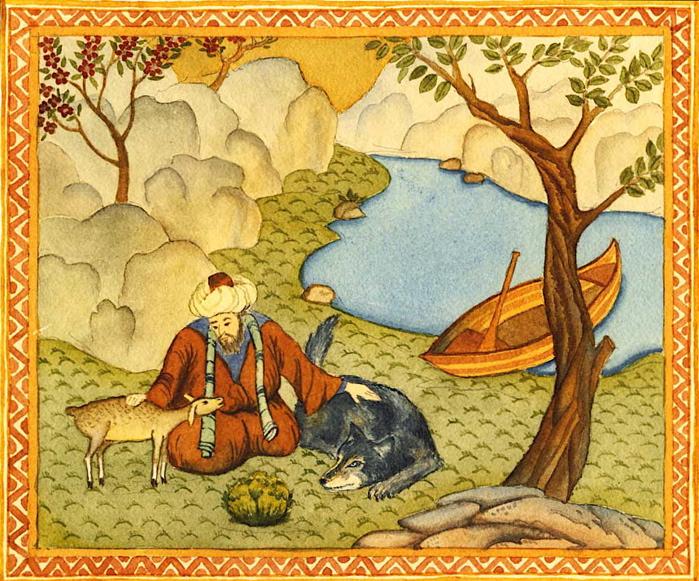
Sufi Saint Pacifying the Animals; c. 18th century Persian miniature courtesy dharmadeen.com
Editor’s Preface: We have previously posted a compilation of Gandhi’s writings on satyagraha. Through these, and by using quotes from his work at the top of our Home page, collected under Quotes & Sources, we hope to provide focal points for discussion, if not statements of doctrine. Please also see the notes at the end for a comment on the texts, and acknowledgments. JG
Non-violence is the greatest force at the disposal of mankind. It is mightier than the mightiest weapon of destruction devised by the ingenuity of man. Destruction is not the law of the humans. Man lives freely by his readiness to die, if need be, at the hands of his brother, never by killing him. Every murder or other injury, no matter for what cause, committed or inflicted on another is a crime against humanity. (MM, 49)
The first condition of non-violence is justice all round in every department of life. Perhaps, it is too much to expect of human nature. I do not, however, think so. No one should dogmatize about the capacity of human nature for degradation or exaltation. (MT, V, 344)
Read the rest of this article »
by Mohandas K. Gandhi

“Soul Force”; courtesy kurdistancommentary.wordpress.com
Editor’s Preface: We have periodically revisited Gandhi’s own definitions of his major concepts. Through compilations of various of his statements, and by using quotes from his work at the top of our Home page, and found under Quotes & Sources, we hope to provide focal points for discussion, if not statements of doctrine. Please also see the note at the end for acknowledgments. JG
My goal is friendship with the world and I can combine the greatest love with the greatest opposition to wrong. (Young India, 10 March 1920; p. 5)
Non-violence is not a resignation from all real fighting against wickedness. On the contrary, the Non-violence of my conception is a more active and more real fighting against wickedness than retaliation, whose very nature is to increase wickedness. I contemplate a mental and therefore a moral opposition to immoralities. I seek entirely to blunt the edge of the tyrant’s sword, not by putting up against it a sharper-edged weapon but by disappointing his expectation that I would be offering physical resistance. The resistance of the soul that I should offer instead would elude him. It would at first dazzle him and at last compel recognition from him, which recognition would not humiliate him but would uplift him. (Young India, 8 October 1925; p. 346)
Read the rest of this article »
by M. K. Gandhi
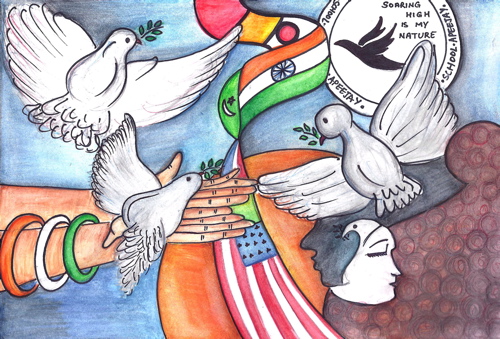
Peace Quilt designed by 9th grader Vidhi Jain, Apeejay School, Pitampura, India; courtesy peacequilt.wordpress.com
Editor’s Preface: We have posted a series of statements by Gandhi that very much address situations and conflicts we currently face, as with his statements on Truth. The “nuclear menace” is much in the news again. These extracts are then being posted in August, the anniversary month of the bombings of Hiroshima and Nagasaki. Please consult the notes at the end for notes, and sources. JG
Has not the atom bomb proved the futility of all violence? (1)
There have been cataclysmic changes in the world. Do I still adhere to my faith in truth and non-violence? Has not the atom bomb exploded that faith? Not only has it not done so, but it has clearly demonstrated to me that truth and non-violence constitute the mightiest force in the world. Before it the atom bomb is of no effect. The two opposing forces are wholly different in kind, the one moral and spiritual, the other physical and material. The one is infinitely superior to the other which by its very nature has an end.
Read the rest of this article »
by Mohandas K. Gandhi
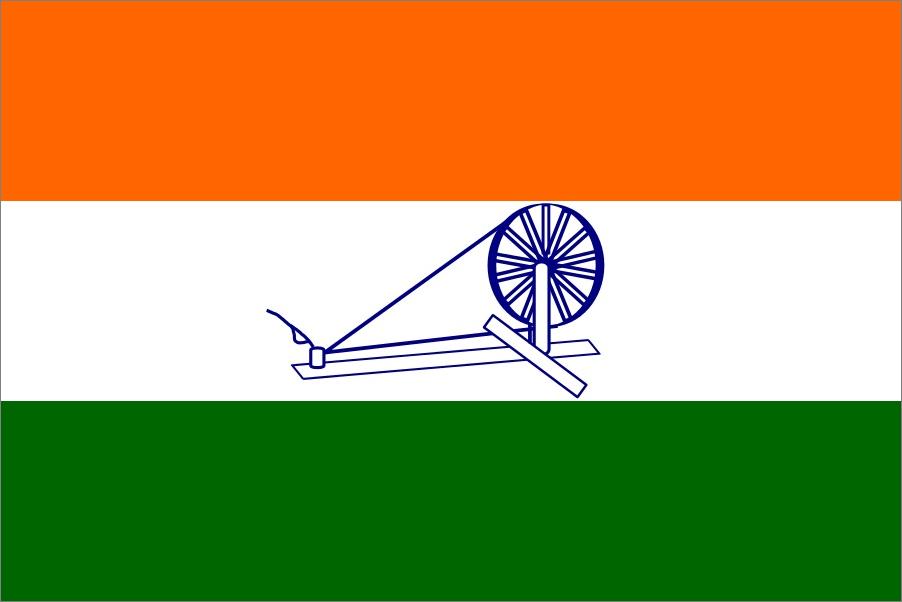
1929 proposed flag of India, with Gandhian spinning wheel; courtesy en.wikipedia.org
Editor’s Preface: The Indian National Congress formally approved “The Declaration of the Independence of India” on December 19, 1929, and it is important to understand it in its historical context. (1) Purna swaraj can be translated as “complete, sovereign independence,” that is, Indian independence from Great Britain and the ending of colonial rule. Various models had been proposed for Indian sovereignty prior to 1930, including several versions of power sharing. However, a sequence of events by the British government, violating or curtailing Indian civil rights, resounded as a betrayal to Gandhi. The “Declaration” marks a turning point in Gandhi’s thinking about Britain, and the nature of India’s future relationship with British rule. (2) There has been some disagreement as to its authorship, but Gandhi can be said to have solved the matter in February 1937 when he wrote,“ I was its author. I wanted the people not merely to repeat the mantra of independence but to educate the people as to its why and wherefore.” (3) Purna Swaraj was to be read throughout the country on January 26, 1930, and that date is still celebrated as India Independence Day. Please also see our explanatory notes at the end. JG
Purna Swaraj
We believe that it is the inalienable right of the Indian people, as of any other people, to have freedom and to enjoy the fruits of their toil and have the necessities of life, so that they may have full opportunities of growth. We believe also that if any government deprives a people of these rights and oppresses them the people have a further right to alter it or to abolish it. The British Government in India has not only deprived the Indian people of their freedom but has based itself on the exploitation of the masses, and has ruined India economically, politically, culturally, and spiritually. We believe, therefore, that India must sever the British connection and attain Purna Swaraj, or complete independence.
Read the rest of this article »
by Mohandas K. Gandhi
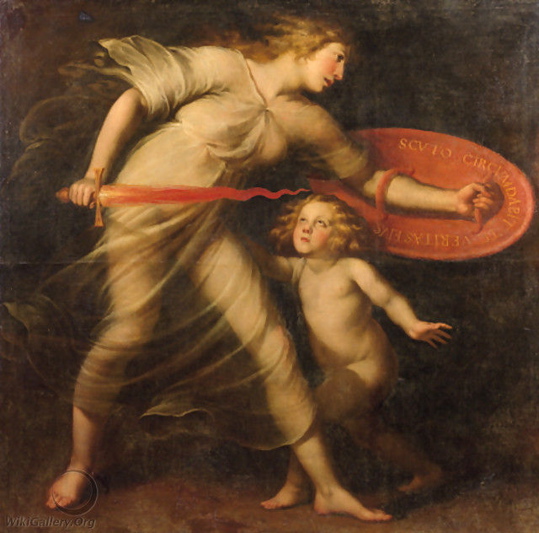
School of Andries Cornelis Lens, “Truth Protecting Us with Her Shield”, c. 1750; courtesy wikigallery.org
Editor’s Preface: “Truth”, “lies”, “alternate facts”, “post-truth politics”, etc., are terms very much in the air these days. Gandhi had much to say about Truth; the selection below is only a small sample focused on the root concepts behind his use of the term, and by application the root of his theory of nonviolence. This is the first of a series of articles we will be posting over the next few months on truth and truth in politics. Other statements on Satyagraha and Truth can be found on our Quotes and Sources page, via the link at the top of the page. JG
(I) The word Satya (Truth) is derived from Sat, which means ‘being’. Nothing is or exists in reality except Truth. That is why Sat or Truth is perhaps the most important name of God. In fact it is more correct to say that Truth is God, than to say that God is Truth. But as we cannot do without a ruler or a general, such names of God as ‘King of Kings’ or ‘The Almighty’ are and will remain generally current. On deeper thinking, however, it will be realised, that Truth (Sat or Satya) is the only correct and fully significant name for God.
And where there is Truth, there also is true knowledge. Where there is no Truth, there can be no true knowledge. That is why the word Chit or knowledge is associated with the name of God. And where there is true knowledge, there is always bliss (Ananda). There sorrow has no place. And even as Truth is eternal, so is the bliss derived from it. Hence we know God as Sat-Chit-Ananda, one who combines in Himself Truth, knowledge and bliss. (1)
Read the rest of this article »
by Mohandas K. Gandhi
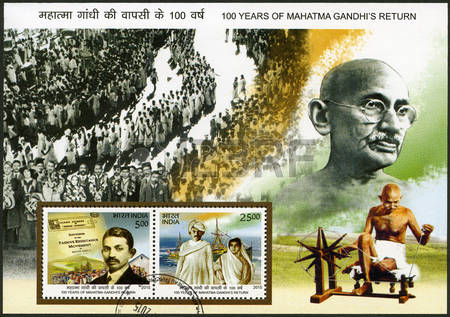
Gandhi poster commemorating his 1915 return to Indian from South Africa, courtesy www.123rf.com
Editor’s Preface: This is the last in our series of articles from the IISG/War Resisters’ International archive; it was first published in the May 3, 1946 issue of Peace News. We have selected this particular article because of Gandhi’s criticism of destruction of property, a tactic used by the Vietnam War protest movement, as with the burning of draft files. The discussion was later revisited by Occupy, and especially Occupy Oakland. Please also consult the notes at the end. JG
“I plead now for non-violence and yet more non-violence.” M. K. Gandhi
Hatred is in the air and impatient lovers of India will gladly take advantage of it, if they can, through violence, to further the cause of independence. That is wrong at any time and everywhere, but it is more wrong in a country where fighters for freedom have declared to the world that their policy is truth and non-violence.
Read the rest of this article »
by M. K. Gandhi
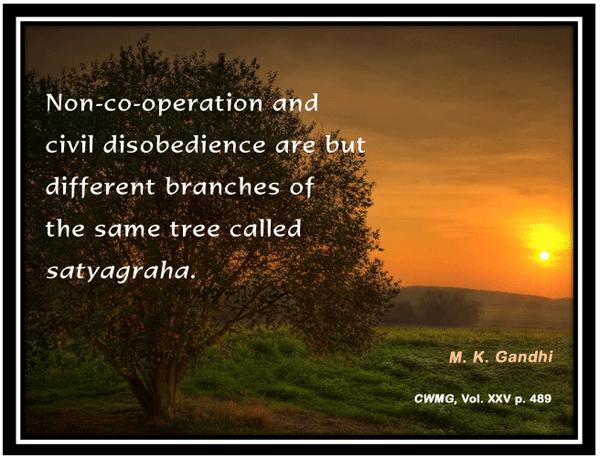
Poster image courtesy mkgandhi-sarvodaya.blogspot.nl
Editor’s Preface: Gandhi did not expound his philosophy of satyagraha in any organized way; there are scattered discussions, remarks and definitions throughout his work. Although there have been anthologies of some of these writings, such as Schocken Books’s, M. K. Gandhi Non-Violent Resistance (New York, 1961), the three extracts below from journals that Gandhi edited have not been anthologized. Please consult the note on the text at the end for an explanation of our editing procedure and acknowledgments. JG
[Extract One] The principles of satyagraha, as I know it today, constitute a gradual evolution. Satyagraha differs from Passive Resistance as the North Pole from the South. The latter has been conceived as a weapon of the weak and does not exclude the use of physical force or violence for the purpose of gaining one’s end, whereas satyagraha has been conceived as a weapon of the strongest and excludes the use of violence in any shape or form.
Read the rest of this article »
by M.K. Gandhi
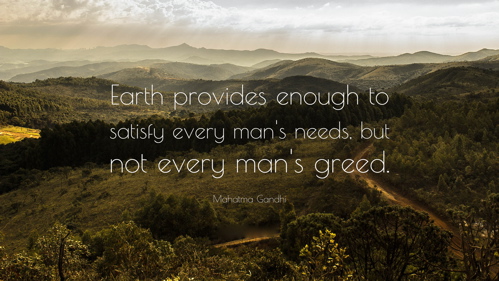
Poster art courtesy quotefancy.com
Editor’s Preface: This is the text of a speech, which Gandhi delivered in 1916. It is increasingly being cited as a key statement of his economic philosophy, most recently by Anthony J. Parel in his influential study, Gandhi’s Philosophy and the Quest for Harmony (Cambridge: Cambridge University Press, 2006, p. 81). It continues our series of making available important documents by Gandhi that we see increasingly cited in the literature. Please click on Gandhi’s byline above for easy access to our other postings, and please also see the Endnotes, and the note on the text, for acknowledgments and further information. JG
‘Does economic progress clash with real progress?’ When I accepted Mr. Kapildeva Malaviya’s invitation to speak to you upon the subject of this evening, I was painfully conscious of my limitations. (1) You are an economic society. You have chosen distinguished specialists for the subjects included in your syllabus for this year and the next. I seem to be the only speaker ill fitted for the task set before him.
Frankly and truly, I know very little of economics, as you naturally understand them. Only the other day, sitting at an evening meal, a civilian friend deluged me with a series of questions on my crankisms. As he proceeded in his cross-examination, I being a willing victim, he found no difficulty in discovering my gross ignorance of the matter. I appeared to him to be handling with a cocksureness worthy only of a man who knows not that he knows not. To his horror and even indignation, I suppose, he found that I had not even read books on economics by such well-known authorities as Mill, Marshall, Adam Smith and a host of such other authors. (1) In despair, he ended by advising me to read these works before experimenting in matters economic at the expense of the public. He little knew that I was a sinner past redemption. My experiments continue at the expense of trusting friends. For, there come to us moments in life when about some things we need no proof from without. A little voice within us tells us, ‘You are on the right track, move neither to your left nor right, but keep to the straight and narrow way.’ With such help we march forward slowly indeed, but surely and steadily. That is my position.
Read the rest of this article »
by Mohandas Gandhi
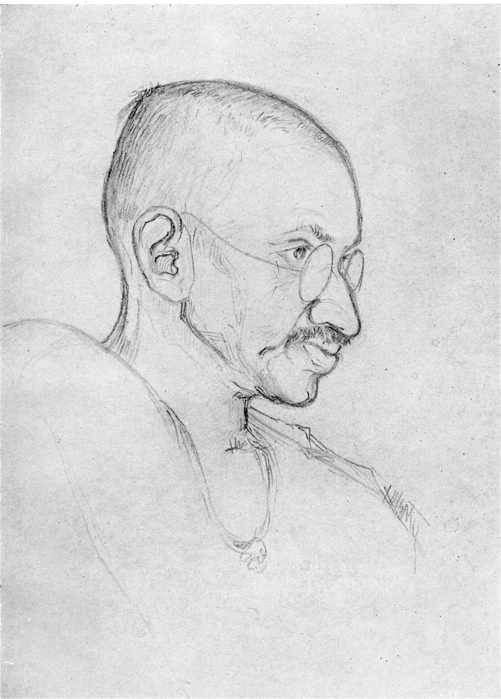
Pencil drawing of Gandhi, 1931, by Kanu Desai; courtesy Golden Vista Press
Editor’s Preface: This article, another in our WRI project, is from The War Resister: Quarterly News Sheet of the War Resisters’ International, issue XXVII, Winter 1930-1931. Pre-World War II, European pacifists were slow to come under the influence of Gandhi. They had disavowed violence in all its forms, but were not always sure that Gandhian satyagraha was an equal commitment. WRI consistently supported Indian independence and self-rule, and about this aspect of Gandhism there was no ambivalence. Please also see the archive reference information and acknowledgments at the end. JG
Here in Gujarat well tried and popular public servants have been arrested one after another, and yet the people have been perfectly nonviolent. They have refused to give way to panic, and have celebrated the arrests, by offering civil disobedience in ever-increasing numbers. This is just as it should be.
If the struggle so auspiciously begun is continued in the same spirit of nonviolence to the end, not only shall we see Purna Swaraj [complete independence] in our country before long, but we shall also have given the world an object lesson worthy of India and her glorious past.
Swaraj [self-rule] won without sacrifice cannot last long. I would therefore like our people to get ready to make the highest sacrifice they are capable of. In true sacrifice all the suffering is on one side; one is required to master the art of getting killed without killing, of gaining life by losing it. May India live up to this mantra . . .
Read the rest of this article »
by Mohandas K. Gandhi
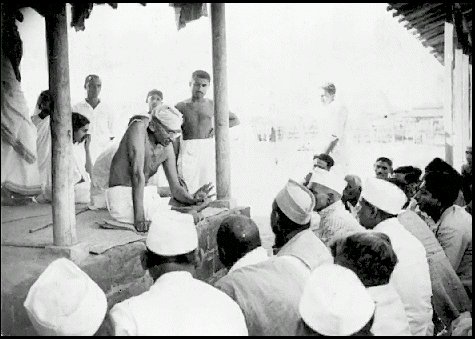
Gandhi teaching his followers; courtesy mkgandhi.org
Editor’s Preface: Gandhi highly valued education as an essential part of his nonviolence program, and insisted it be included in the daily life of the various ashrams that he founded. (1) If regular classes were held for children, adults were also asked to learn spinning, weaving, cloth making, and a host of other skills. It was not until 1909, however, that Gandhi began to systematize his thoughts, in the essay that follows. It is, in fact, Chapter 18 of one of his most important and influential works, Hind Swaraj or Indian Home Rule, presented as a series of questions and answers between the fictitious, if sometimes obtuse “Reader”, and answers by a knowing “Editor”, both of whom, needless to say are Gandhi. Hind Swaraj was written in a flurry of work between 13 and 22 November 1909 while Gandhi was on board the Kilnonan Castle sailing back from England to South Africa. Although he continued to write about education in Young India, Indian Opinion, and other of the periodicals he edited, the text that follows is recognized as his first attempt to outline the basics of a curriculum consisting of language, Indian civilization, and ethics. Please consult the notes at the end for further bibliographical information. JG
Reader: In the whole of our discussion, you have not demonstrated the necessity for education; we always complain of its absence among us. We notice a movement for compulsory education in our country. The Maharaja Gaekwar has introduced it in his territories. (2) Every eye is directed towards them. We bless the Maharaja for it. Is all this effort then of no use?
Editor: If we consider our civilization to be the highest, I have regretfully to say that much of the effort you have described is of no use. The motive of the Maharaja and other great leaders who have been working in this direction is perfectly pure. They, therefore, undoubtedly deserve great praise. But we cannot conceal from ourselves the result that is likely to flow from their effort. What is the meaning of education? It simply means knowledge of letters. It is merely an instrument, and an instrument may be well used or abused. The same instrument that may be used to cure a patient may be used to take his life, and so may knowledge of letters. We daily observe that many men abuse it and very few make good use of it; and if this is a correct statement, we have proved that more harm has been done by it than good. (3)
Read the rest of this article »














